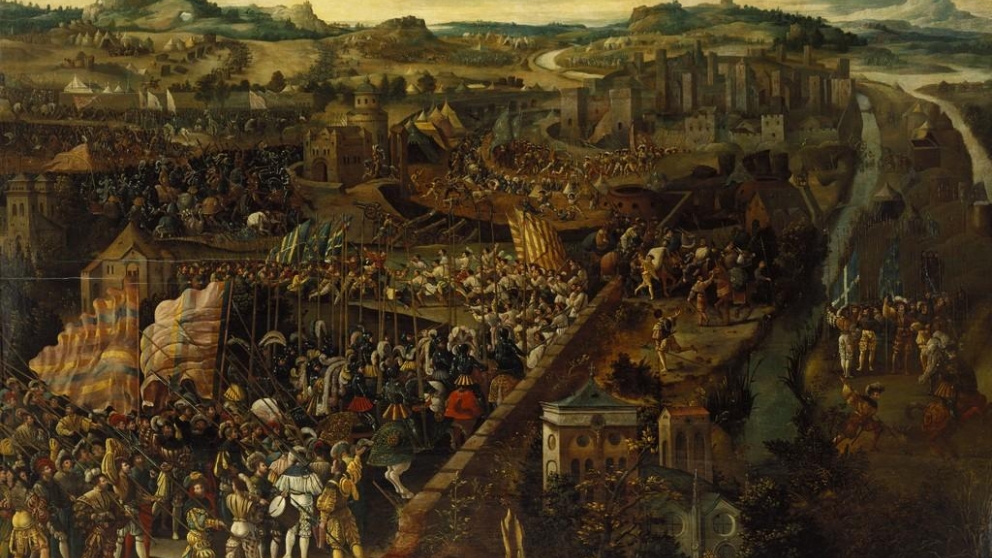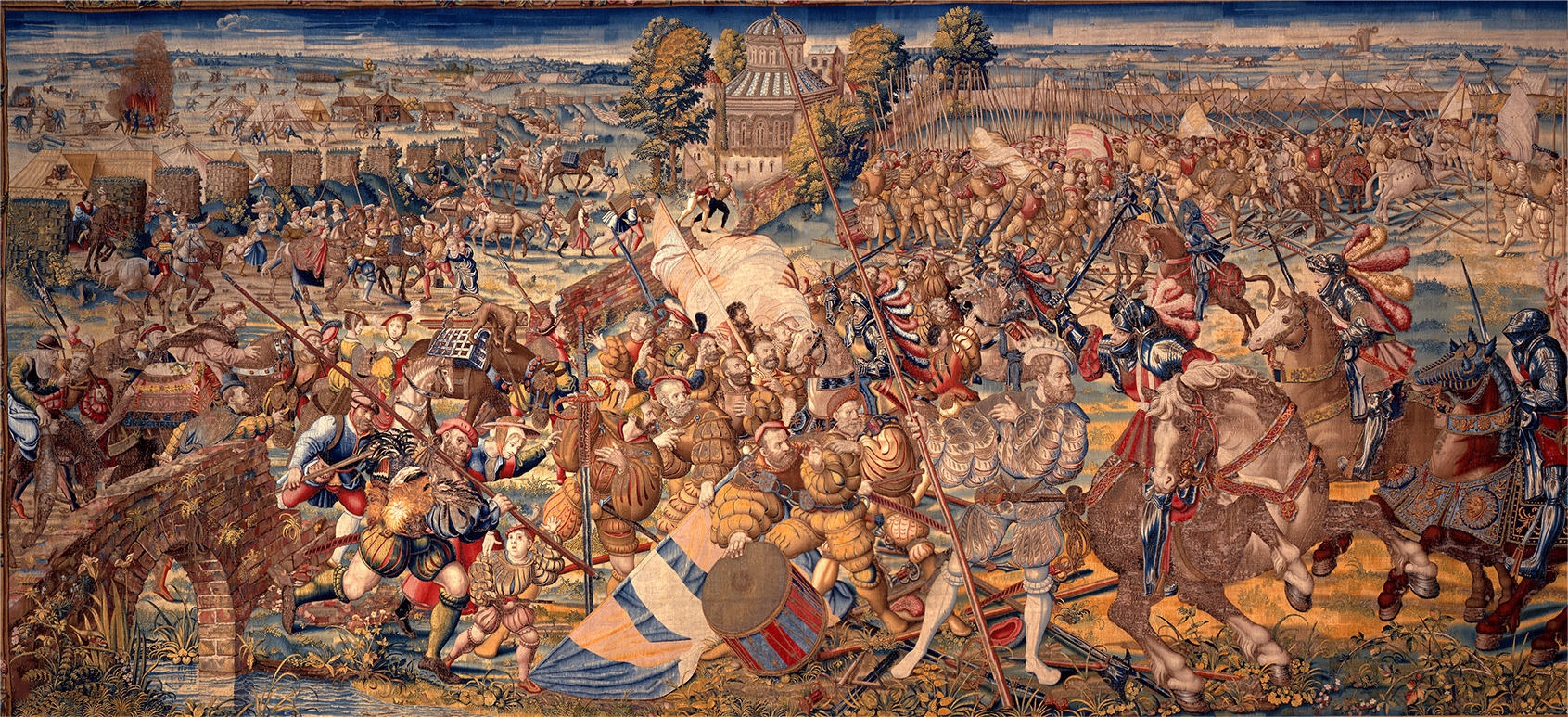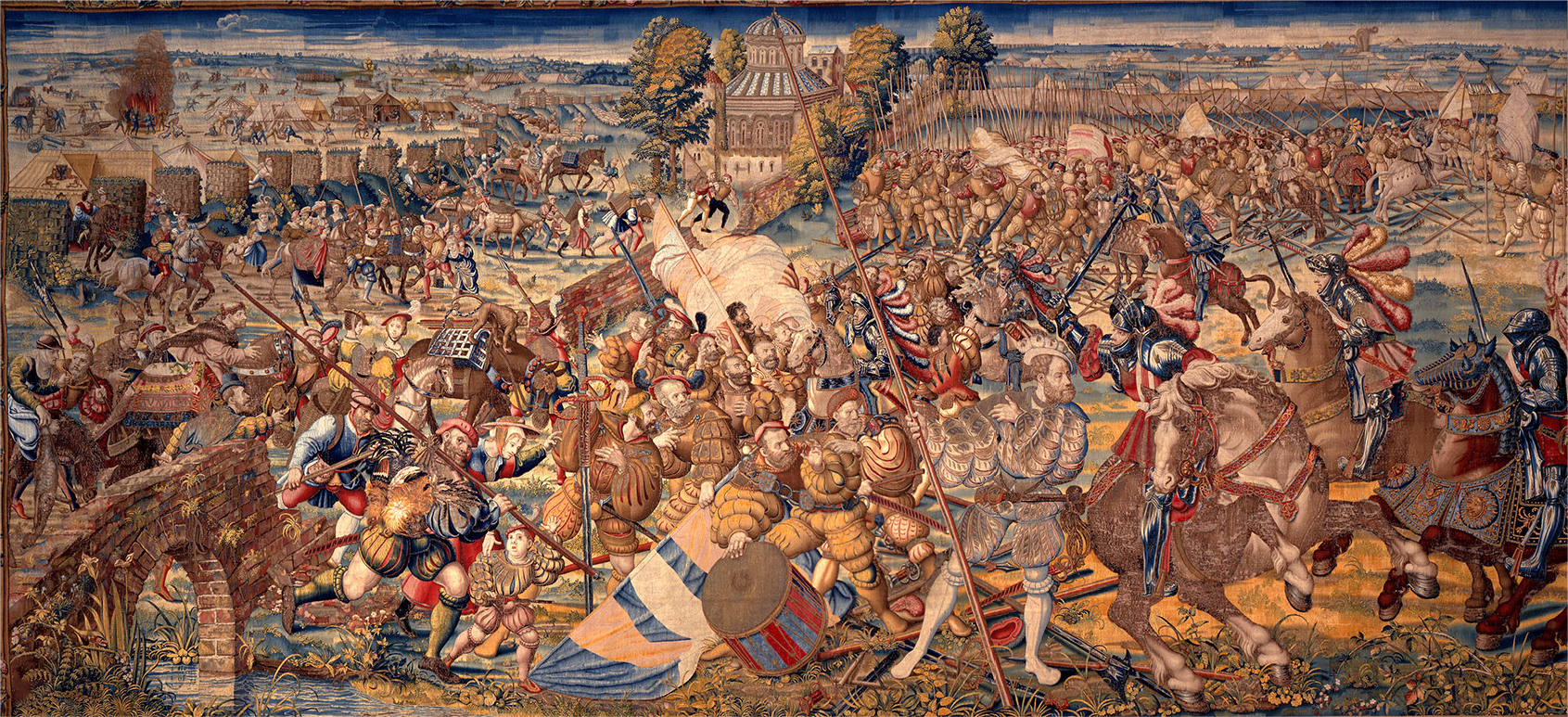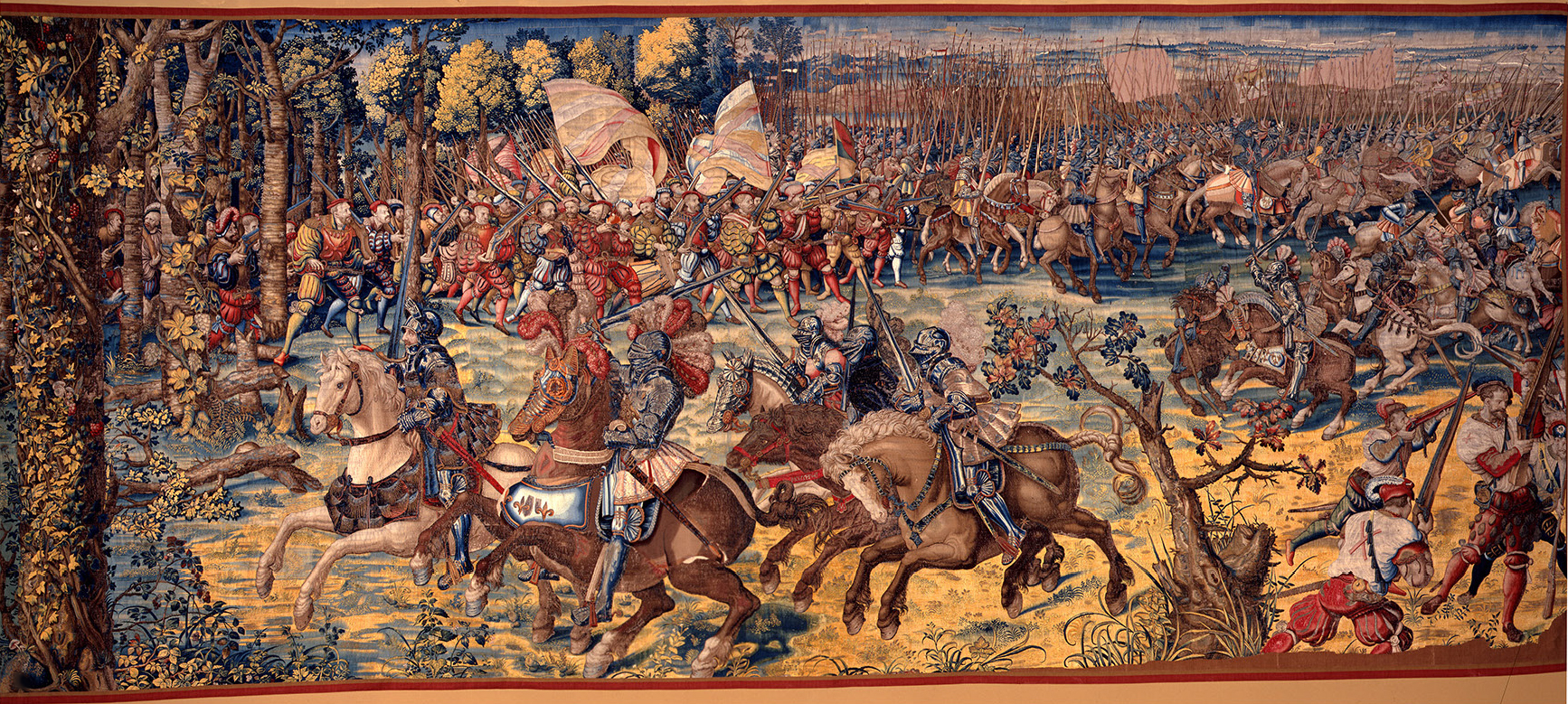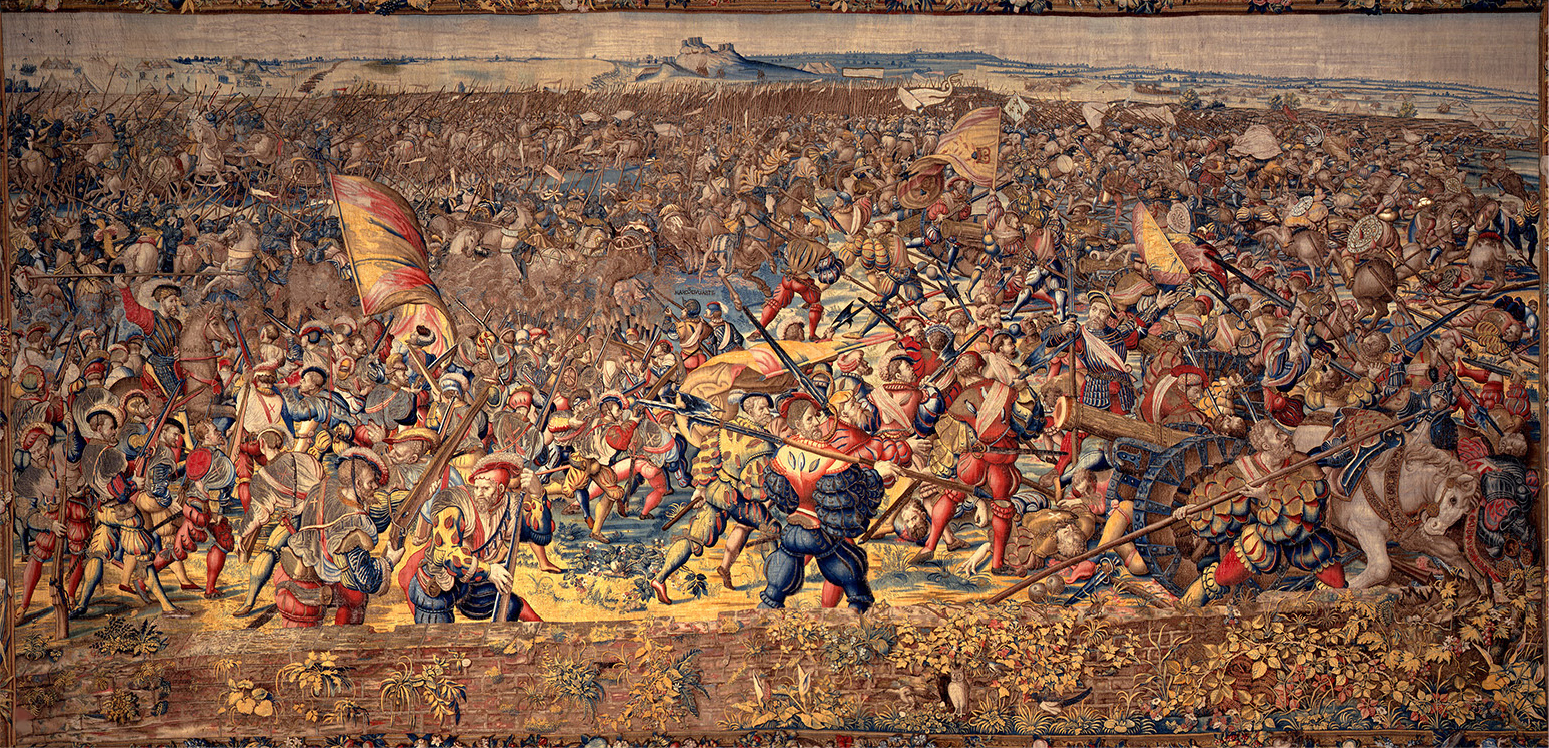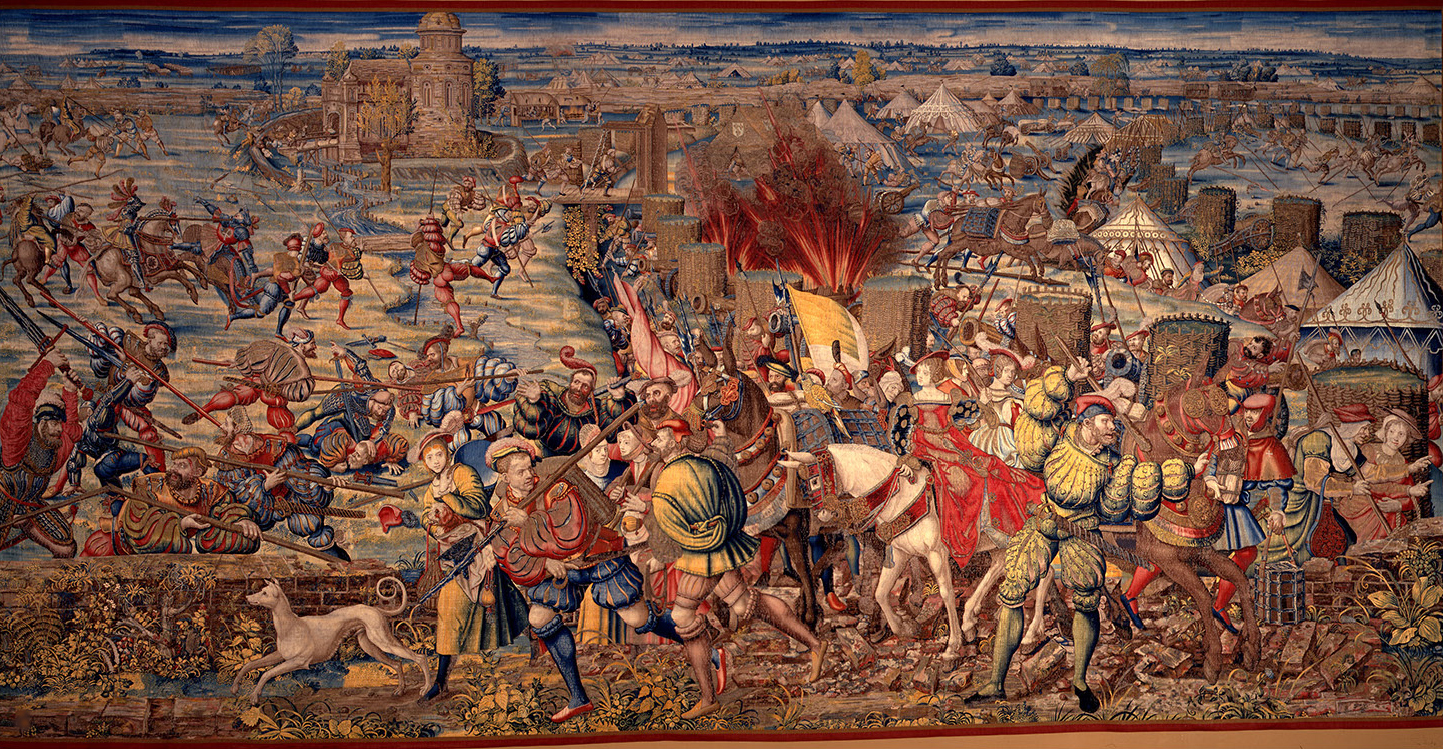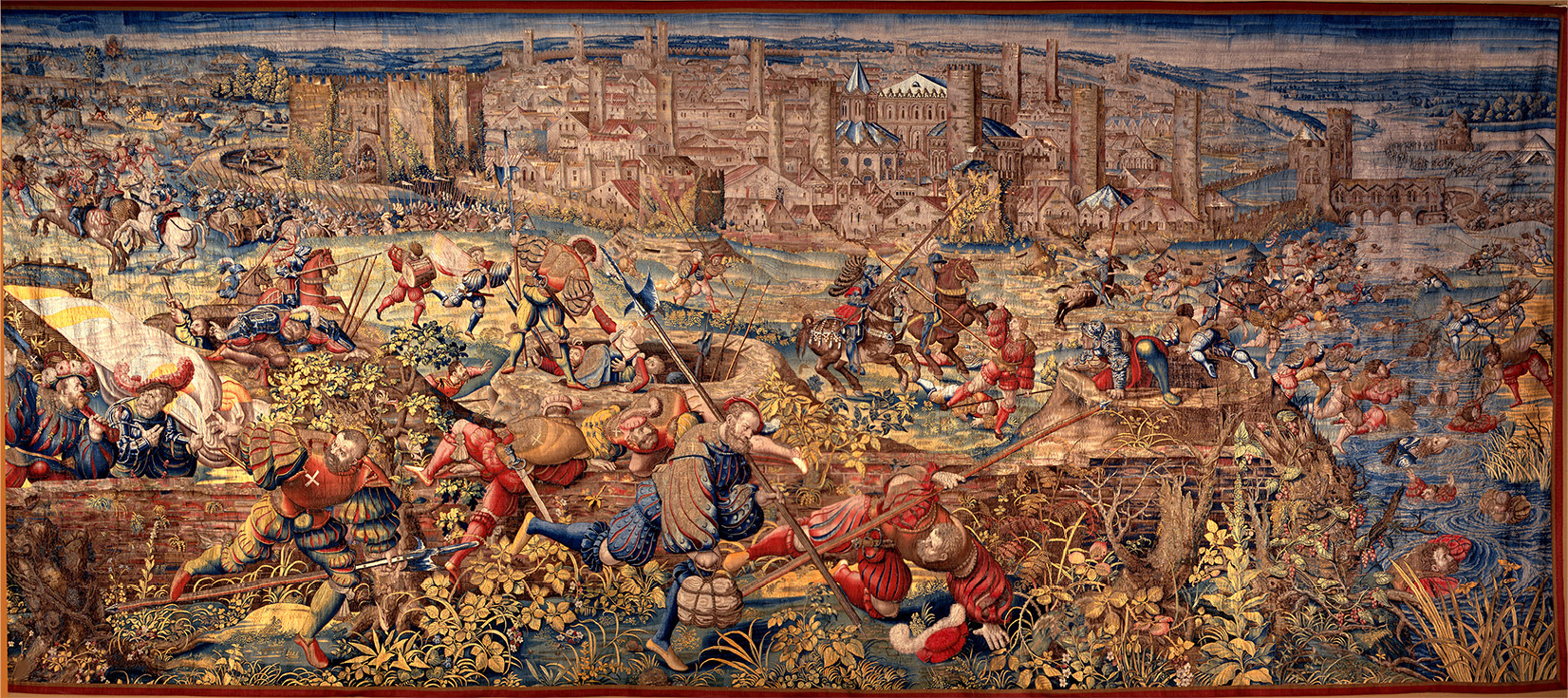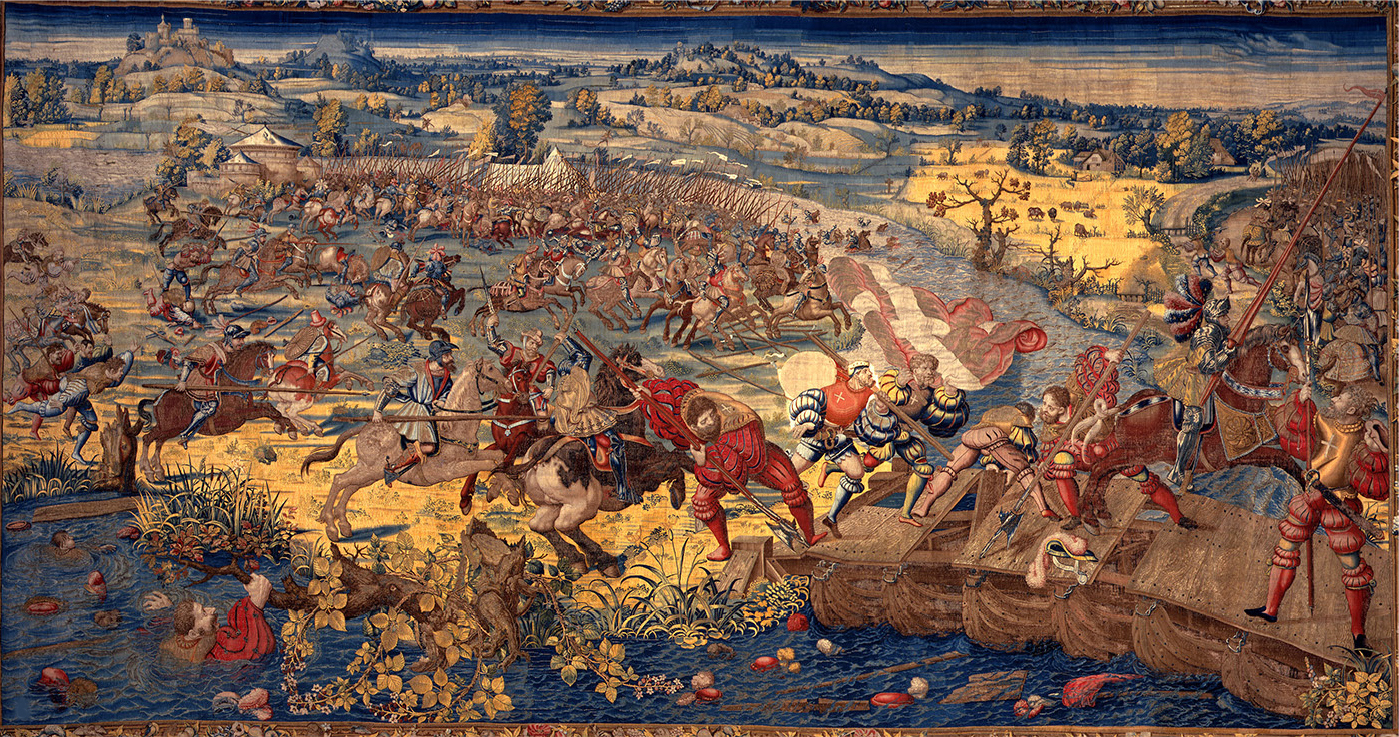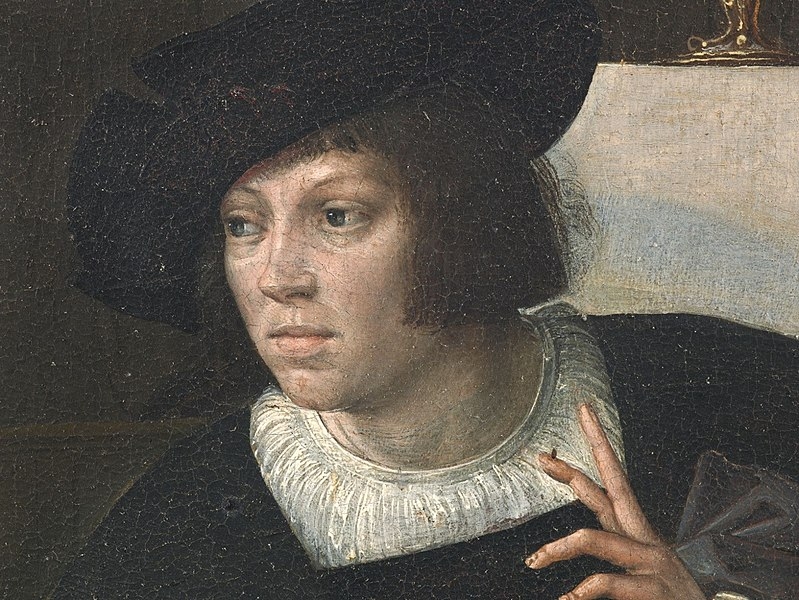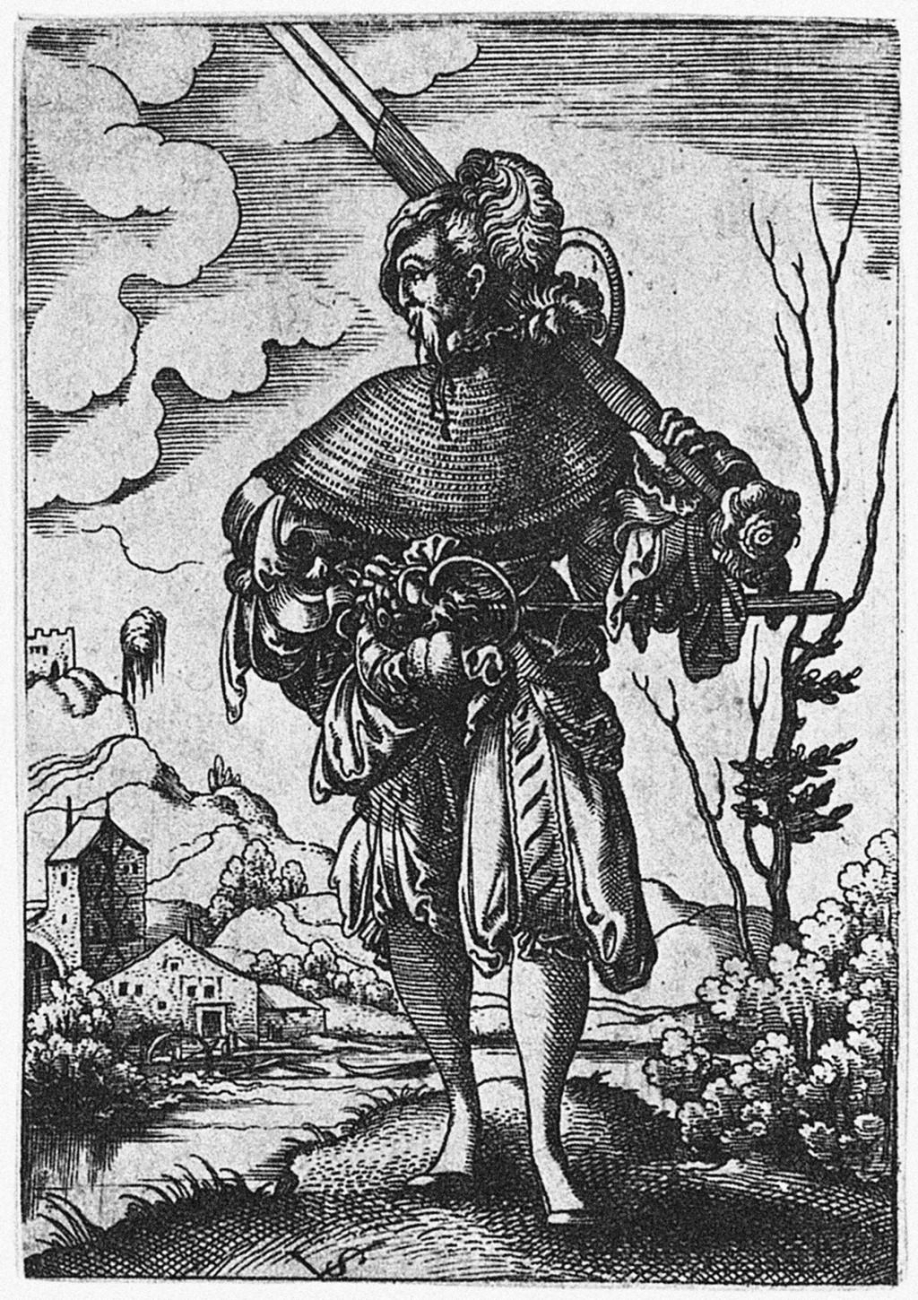Tapestries of the Battle of Pavia
Introduction
Thousands of soldiers emerge from the woods, arquebuses and halberds in hand, preparing to fight against the vast French army. The Battle of Pavia tapestry series captures the famous Battle of Pavia, fought between the Habsburgs and French, resulting in a Habsburg victory. These tapestries depict a range of scenes from the battle, including the capture of French King Francis I, the rout of the Swiss, and the retreat of the French army. Within the tapestry, a vast amount of emphasis is placed upon the landsknecht soldiers, landsknecht being the German word for mercenary, who played an instrumental part in the victory of the Habsburgs over the French army. The tapestries themselves connect to a wider image of European consumption, trade and mercenary lifestyles. The tapestries of the Battle of Pavia showcase Europeans conspicuous consumption of luxury goods, their connection to the global trade network, and mercenary culture.
Role of Tapestries in Renaissance Europe
For the wealthy of Renaissance Europe, tapestries represented grandeur, wealth, and status, as well as the conspicuous consumption of luxury goods. Practically, they served as both an aesthetic adornment for the home, and a way of insulating cold stone buildings. By analyzing the tapestries of the Battle of Pavia we can learn the role of these material objects in the daily life of those who could afford them. The provenance of these tapestries provides significant clues to their function.
We know that this tapestry series was produced on commission from the States General of the Brussels royal palace as a gift to Emperor Charles V to celebrate the enthronement of his younger sister, Mary of Hungary, as regent of the Netherlands [1]. The artist responsible for the tapestries design, Bernaert van Orley, would go on to serve as court painter for Margaret of Austria, and Mary of Hungary [2]. This institutional transaction speaks to the significant role tapestries and other luxury goods had as diplomatic gifts in the royal courts of Europe [3].
Tapestries were also an important signifier of Church authority, exhibiting the wealth within Church coffers via an expensive material good. Cathedrals would be adorned with woven depictions of saints, biblical passages, and other religious scenes. Significant holy days would often be marked with the dramatic unfurling of tapestries that enhanced the ornamentation of religious buildings [4].
Most importantly, tapestries served as a way for rulers to demonstrate their wealth and, by extension, power. The need for expensive materials and enormous labor input for artists, artisans, and craftsmen made tapestries an item accessible by few in the social hierarchy. Additionally, the portability and expense of tapestries gave them a unique advantage vis-à-vis paintings and other luxury goods as they could be easily rolled, transported, and stored by traveling nobles [5].
“Tapestries were indispensable to the articulation of a ruler’s authority and might…A ruler could not do without tapestries, and contemporaries paid attention to these expressions of wealth.” [6]
Tapestry Production and Trade
The production and consumption of tapestries represents their position in a network of global trade. The tapestries of the Battle of Pavia show how far the weaving industry of the Renaissance Low Countries reached, as these were one of the most sought after manufactured artifacts of the region [7].
The process of tapestry production involved different layers of design, drafting, and production, usually undertaken by different groups located in different towns or even other countries [8]. Tapestry designs were generally provided by a painter or other artist, and then passed on to weavers for production [9]. The logistics and funding of this process would be furnished by a merchant, either on behalf of a client via commission or for sale on the open market [10].
The Battle of Pavia series was woven in the Dermoyen Workshop of Brussels [11]. Belgium and the Netherlands had a near monopoly on tapestry production between the late 15th and early 16th century, so this would have been standard [12]. Brussels was famed for its tapestries, even becoming one of the largest manufacturers of the item for the Catholic Church [13]. The Low Countries were the only region at the time with the expertise, logistics, and materials to allow for fast, high quality tapestry production [14].
The production of tapestries was also an international effort, bringing in expertise and materials from inside and outside Europe. Antwerp was one of the most vibrant trading centers of the period, rivaled only by Venice in terms of its pigment market [15]. Along with dye, one could expect to see silk from China, wool from England, and precious metals from Spain’s colonial empire [16]. The Battle of Pavia tapestries show many of these elements, incorporating imported gold-wrapped thread silk in its weave [17]. Tapestries sat at the center of global production and consumption that necessitated tight coordination between different groups and a robust trade network.
Landsknecht and Mercenary Culture
The Battle of Pavia depiction of landsknechts helps inform us about the nature of landsknecht soldiers and the lives that they lived. A landsknecht soldier was typically a German mercenary, [18] but sometimes would include other Europeans, such as Scots [19]. Most landsknechts came from poor backgrounds [20], while some groups of landsknechts were made entirely of criminals, who would be released from prison and forced to fight [21].
Most enlistees viewed the mercenary life as a way to escape poverty, but in reality, the life of a landsknecht was not an escape from poverty, only a continuation of it, as many landsknecht soldiers would stay poor during their time as a mercenary [22]. As seen within the tapestries, the landsknecht soldier was not equipped with heavy armor and are not even weaning helmets, while the knights are wearing full body armor and helmets, emphasizing the landsknecht’s lack of wealth. Some landsknechts did have a certain degree of wealth, however, they were mostly captains of landsknecht groups. These captains would typically be exiled nobles or a younger sibling in a noble family, with the overall goal to make a name for themselves [23].
In Scotland, it was not uncommon for an illegitimate or young son of a Scottish noble family to raise their own contingent of soldiers and travel to continental Europe in search of wealth and glory [24]. Therefore, landsknechts units would become melting pots of different European cultures, as a unit could be composed of individuals of Dutch, German, Scottish, Swiss and other ethnic backgrounds. This melting pot would contribute to the Landsknechts not having a single religious identity, as during multiple conflicts between Protestants and Catholics, landsknechts would fight on both sides.
During the Sack of Rome in 1527, Protestant Landsknechts for the Italian League would clash against the Swiss Guard, with the two groups fighting viciously against each other until the Swiss Guard was forced to retreat [25]. The Swiss Guard were originally a group of Swiss landsknechts, however, Pope Julius II was so impressed with their military prowess he recruited them to be his personal guard [26]. Within the Battle of Pavia tapestries, the landsknechts depicted in the piece are fighting for the Protestant Habsburgs against the Catholic French [27]. To most landsknechts, religion was a secondary factor at best, as money was far more important to the mercenaries than their religious beliefs.
It was very uncommon to see mercenary groups, such as the Swiss Guard, motivated more by their zealotry than the opportunity to gain wealth. In fact, during the Sack of Rome, the Protestant Landsknechts were not focused on beating their Catholic opponents because they were Catholic, but were instead focused on pillaging as much gold as possible, as they had not been paid for months [28].The Battle of Pavia tapestries help direct historians towards aspects of the landsknecht lifestyle, such as their lack of material wealth and their various ethnic and religious backgrounds.
Conclusion
The Battle of Pavia tapestries and the context around the tapestries' creation demonstrate a wide range of different themes. In Renaissance Europe, tapestries represent wealth, status, and international consumption for the tapestries' owners. The tapestries’ production showed the economic integration of Western Europe with the broader world and the importance of global trade. The lifestyle of landsknechts is shown through the tapestries' context and imagery, which weaves the picture of a melting pot of different European cultures, religious beliefs, and social backgrounds. The Battle of Pavia tapestry series demonstrates European consumption of luxurious goods, Europe’s connection to the global trading network, and the life of landsknecht mercenaries.
References
[1]: Thomas Campbell, Tapestry in the Renaissance: Art and Magnificence (New York: Met Publications, 2002), 323.
[2]: Ibid.
[3]: Susie Nash, Northern Renaissance Art (New York: Oxford University Press, 2008), 87 & 88.
[4]: Ibid, 249 & 250.
[5]: Marina Belozerskaya, Luxury Arts of the Renaissance (Los Angeles: Getty Publications, 2005), 98.
[6]: Ibid, 99 & 100.
[7]: Nash, Northern Renaissance Art, 87.
[8]: Ibid, 209.
[9]: Ibid.
[10]: Ibid.
[11]: Belozerskaya, Luxury Arts of the Renaissance, 114.
[12]: Nash, Northern Renaissance Art, 88.
[13]: Ibid.
[14]: Ibid.
[15]: Ibid, 199.
[16]: Belozerskaya, Luxury Arts of the Renaissance, 121.
[17]: Campbell, Tapestry in the Renaissance: Art and Magnificence, 327.
[18]: Peter Halden, “Organized Armed Groups as Ruling Organizations,” Armed Forces & Society 44, no. 4 (October 2018), 611.
[19]: James Miller, “The Scottish Mercenary as a Migrant Labourer in Europe, 1550-1650,” in Fighting for a Living: A Comparative Study of Military Labour 1500-2000, ed. Erik-Jan Zurcher (Amsterdam, Netherlands: Amsterdam University Press, 2013), 169-200, at 182.
[20]: Erik Swart, “From “Landsknecht” to “Soldier”: The Low German Foot Soldiers of the Low Countries in the Second Half of the Sixteenth Century,” International Review of Social History 51, no. 1 (April 2006), 75-92, at 75 & 77.
[21]: Ibid, 77.
[22]: Ibid, 75.
[23]: Ibid, 78.
[24]: Miller, “The Scottish Mercenary,” 182-183.
[25]: Robert Royal, The Pope’s Army: 500 Years of the Papal Swiss Guard (New York, NY: The Crossroad Publishing Company, 2006), 74-75.
[26]: Ibid
[27]: Patrick Brugh, Gunpowder, Masculinity and Warfare in German Texts, 1400-1700 (Rochester, NY: University of Rochester Press, 2019), 41.
[28]: Royal, The Pope's Army, 73-76.
